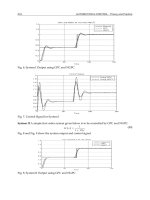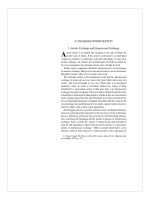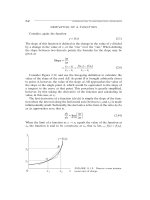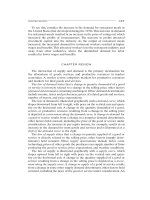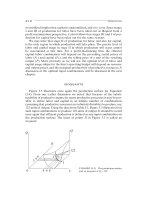Lecture Leadership - Theory and practice: Chapter 10 – Team leadership
Bạn đang xem bản rút gọn của tài liệu. Xem và tải ngay bản đầy đủ của tài liệu tại đây (1.05 MB, 38 trang )
Chapter 10 - Team Leadership
Leadership
Chapter 10 – Team Leadership
Northouse, 4th edition
Chapter 10 - Team Leadership
Overview
Team Leadership Perspective
Team Leadership Model
Leadership Decisions
Leadership Actions
Team Effectiveness
Principled Leadership
How does the Team Leadership Model Work?
Chapter 10 - Team Leadership
Historical Perspective of Team
Leadership – 1920s-1980s
20-30s
• Human
Relations
movement
40s
50s
• Group
dynamics
• Social
• Collaborative science
efforts at
theory
work
• T group
• Leader’s
role in
T group
60-70s
80s
• Organizational
development
• Quality
• Team
leader
effectiveness
• Benchmarking
teams
• Continuous
improvement
Chapter 10 - Team Leadership
Historical Perspective of Team
Leadership – 1990s
Parker
90s
• Global
1990
perspective
• Group
dynamics
• Flatter
organizational
structure
• Social
science
theory
• Strategies
for
competitive
advantage
• Team-based,
technology
enabled
Effectiveness research
The use of teams has led
to:
– Greater productivity
– More effective use of
resources
– Better decisions & problem
solving
– Better-quality products &
services
– Increased innovation &
creativity
Chapter 10 - Team Leadership
Team Leadership Description
Perspective
Team research (Ilgen, Hollenbeck Johnson & Jundt, 2005)
– Focus on team variables
– Role of affective, behavioral & cognitive processes in
team success
– Team performance & viability
Role of mediating processes such as:
Trusting, bonding, planning, adapting, structuring & learning
Issues
– Difficult to understand the team process because of its
complexity
– Leader ineffectiveness is major obstacle to overall
team effectiveness
Chapter 10 - Team Leadership
Team Leadership Description
Objectives
Critical factor in success of organizational
teams – understand role of leadership in
teams:
– Ensure team success & avoid team failure
Functions a leader must perform
– Complexity involved in performing these functions
– How performance of these complex functions relates
to actual team performance
Team leadership capacity –
– Shared or distributed leadership
– Encompasses entire team
Chapter 10 - Team Leadership
Team Leadership Model
Description
Model provides leader or designated team
member with a mental road map to help
– Diagnose team problems, and
– Take appropriate action to correct team problems
Effective team performance begins with leader’s
mental model of the situation
Mental model reflects
– Components of the problem
– Environmental & organizational contingencies
Chapter 10 - Team Leadership
Team Leadership Model
Description
Leadership behavior
– Seen as team-based problem solving
Leader uses discretion
– Which problems need intervention
– Make choices about which solutions are the most
appropriate
Effective leaders have the ability to determine
– What interventions are needed, if any, to solve team
problems
Hill’s Model
for Team
Leadership
Chapter 10 - Team Leadership
Chapter 10 - Team Leadership
Leadership Decisions
1. Continue monitoring the team or take
action based on current information
2. Determine the general task or
relational function of intervention
needed
3. Intervene at internal level (within team)
or external level (team’s environment)
Chapter 10 - Team Leadership
Leadership Decision 1
Should I Monitor the Team
or Take Action?
Leaders can:
– Diagnose, analyze, or forecast problems
(monitoring) or take immediate action to solve
a problem
– Focus on problems within the group (internal) or
– Which problems need intervention
– Make choices about which solutions are the most appropriate
Effective leaders have the ability to determine
– What interventions are needed, if any, to solve team problems
Chapter 10 - Team Leadership
Leadership Decision 1
Should I Monitor the Team
or Take Action?
: McGrath’s critical leadership functions – two
dimensions of leadership behavior:
– Monitoring vs. taking action
We can diagnose, analyze, or forecast problems (monitoring)
or take immediate action to solve a problem
– Internal group issues vs. external group issues
Focus on the problems within the group (internal) or problems
outside the group (external)
Two dimensions result in 4 types of group leadership
functions
Chapter 10 - Team Leadership
Leadership Decision 1
Chapter 10 - Team Leadership
Leadership Decision 2
Should I Intervene to Meet
Task or Relational Needs?
Leaders can:
– Determine if team needs help in dealing
with relational issues or task issues
– Task functions include:
Getting job done
Making decisions
Solving problems
Adapting to change
Making plans
Achieving goals
Chapter 10 - Team Leadership
Leadership Decision 2
Should I Intervene to Meet
Task or Relational Needs?
Leaders can:
– Determine if team needs help in dealing
with relational issues or task issues
– Maintenance functions include:
Developing a positive climate
solving interpersonal problems
Satisfying members’ needs
Developing cohesion
Chapter 10 - Team Leadership
Leadership Decision 3
Should I Intervene
Internally or Externally?
Leader must:
– Determine what level of team process
needs leadership attention:
– Internal task or relational team dynamics, if:
Conflict between group members
Team goals unclear
– External environmental dynamics, if:
Organization
not providing proper support to team
Chapter 10 - Team Leadership
Leadership Actions
Leadership Functions – performed
internally or externally
Chapter 10 - Team Leadership
Leadership Actions
Internal Task Leadership Actions
Set of skills or actions leader might perform
to improve task performance:
– Goal focusing (clarifying, gaining agreement)
– Structuring for results (planning, visioning,
organizing, clarifying roles, delegating)
– Facilitating decision making (informing, controlling,
coordinating, mediating, synthesizing, issue focusing)
– Training team members in task skills (educating,
developing)
– Maintaining standards of excellence (assessing
team and individual performance, confronting
inadequate performance)
Chapter 10 - Team Leadership
Leadership Actions
Internal Relational Leadership Actions
Set of leadership actions leader
needs to implement to improve team
relationships:
– Coaching team members in interpersonal
skills
– Collaborating (including, involving)
– Managing conflict and power issues
(avoiding confrontation, questioning ideas)
Chapter 10 - Team Leadership
Leadership Actions
Internal Relational Leadership Actions
Set of leadership actions leader
needs to implement to improve team
relationships, cont’d.:
– Building commitment and esprit de corps
(being optimistic, innovating, envisioning,
socializing, rewarding, recognizing)
– Satisfying individual member needs
(trusting, supporting, advocating)
– Modeling ethical and principled practices
(fair, consistent,
normative)
Chapter 10 - Team Leadership
Leadership Actions
External Environmental Leadership Actions
Set of skills or behaviors leader needs
to implement to improve environmental
interface with team:
– Networking and forming alliances in
environment (gather information, increase
influence)
– Advocating and representing team to
environment
– Negotiating upward to secure necessary
resources, support, and recognition for team
Chapter 10 - Team Leadership
Leadership Actions
External Environmental Leadership Actions
Set of skills or behaviors leader needs
to implement to improve environmental
interface with team:
– Buffering team members from environmental
distractions
– Assessing environmental indicators of team’s
effectiveness (surveys, evaluations,
performance indicators)
– Sharing relevant environmental information
with team
Chapter 10 - Team Leadership
Team Effectiveness
Team effectiveness – the desired
outcome of teamwork
Team Performance – task
accomplishments
Team Development – maintenance of
the team
Researchers studied organizational work
teams & developed –
– Standard of effectiveness
– Criteria of excellence
Chapter 10 - Team Leadership
Team Effectiveness
Chapter 10 - Team Leadership
Team Effectiveness
Clear, Elevating Goal
– Clear so that one can tell if performance
objective has been met
– Is motivating or involving so that members
believe it is worthwhile and important
Results-Driven Structure
– Need to find the best structure to achieve goals
Clear team member roles
Good communication system
Methods to assess individual performance
An emphasis on fact-based judgments
